Dive Brief:
- Federal Reserve Chair Jerome Powell kept the possibility of an additional interest rate hike on the table even as he noted progress in pushing down inflation toward the central bank’s 2% target.
- “We are prepared to tighten policy further if it becomes appropriate to do so,” Powell said in a speech Friday. “It would be premature to conclude with confidence that we have achieved a sufficiently restrictive stance,” Powell said after noting that the Fed has “reacted forcefully” to high price pressures by raising the main rate since March 2022 from near zero to a range between 5.25 and 5.5%.
- “The strong actions we have taken have moved our policy rate well into restrictive territory,” restraining demand and inflation, Powell said. Policymakers are committed “to keeping policy restrictive until we are confident that inflation is on a path to” the Fed’s 2% goal.
Dive Insight:
Data released in recent weeks show that the most aggressive Fed tightening in 40 years is starting to take hold, with price pressures falling, hiring slowing and the economy cooling.
Core inflation, which excludes volatile food and energy prices, eased to a 2.5% annualized rate during the six months through October, Powell noted, compared with 4.5% during the prior six months. “That progress must continue if we are to reach our 2% objective.”
Economic growth, which defied forecasts of recession early this year and surged 5.2% during the third quarter, will probably slow in coming months, Powell predicted.
Consumer spending — which fuels nearly 70% of economic growth — eased in October to the slowest pace since May. Retail sales fell 0.1% during October in the first decline since March.
Gross domestic product growth will probably fall during the current quarter to a 1.8% annual rate, the Atlanta Fed said in a forecast Thursday. Next year GDP will expand just 1.25% next year, New York Fed President John Williams predicted Thursday.
Despite indications that the Fed is slowing demand, Powell and Williams — who serves as vice chair of the policy-setting Federal Open Market Committee — implicitly pushed back against bets that a rate cut is in the cards.
After saying that the Fed has likely pushed up the federal funds rate to its peak or near-peak level this tightening cycle, Williams added that “the future remains highly uncertain and our decisions will continue to be data dependent.”
“I expect it will be appropriate to maintain a restrictive stance for quite some time to fully restore balance and to bring inflation back to our 2% longer-run goal on a sustained basis,” he said.
Powell, while noting that consumer spending and economic output have slowed, emphasized that the economy since the harshest days of the pandemic has exceeded expectations.
“The economy has repeatedly surprised us and all of the forecasters,” Powell said in response to a question after his speech at Spelman College.
“If you go back a year, not many people — I'm not aware of any people who forecast that we would have quite the level of strong growth that we have had in 2023, around 2.5%, a labor market that's still been creating millions of jobs and yet inflation, beginning in June, coming down very meaningfully,” he said.
Despite the comments by Powell and Williams, traders in interest rate futures are apparently not convinced that policymakers will hold the federal funds rate at its current 22-year high for very long. They set 62% odds that policymakers will cut the main rate at least a quarter point below the current level at the end of a two-day meeting on March 20, according to the CME FedWatch Tool.
Traders see a 97% probability that the FOMC will leave the benchmark rate unchanged at its next scheduled meeting Dec. 12-13.















